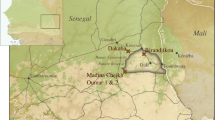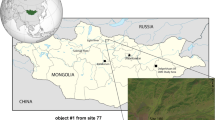Abstract
Recent excavations of a Late to Post-Meroitic furnace workshop at Meroe, Sudan prompted questions concerning the use of some of its unusual design features and the nature of ironmaking practice. To begin addressing these questions, four iron smelting experiments were conducted in a purpose-built workshop modelled from the archaeological remains. Some of the goals of the campaign included identification and testing of potential ore and technical ceramic resources as well as the production of slag with characteristics that mirrored those of the archaeological deposits. The primary objective, however, was the further development of a model for Late to Post-Meroitic direct process iron production. Comparison of the microstructural and chemical characteristics of the archaeological and experimental ironmaking residues leads to a rejection of hypothesised ore sources adjacent to Meroe, support for hypothesised technical ceramic resource locations and a failure to replicate Late–Post-Meroitic smelting slag. However, the comparison also makes a strong contribution to the developing model of smelting practice at Meroe by emphasising the need to create more consistent redox conditions within the furnace, greater standardisation in preparing technical ceramics and the use of relatively lean ores (≈ 60 wt.% Fe).















Similar content being viewed by others
References
Abdu B, Gordon R (2004) Iron artifacts from the land of Kush. J Archaeol Sci 31(7):979–998. https://doi.org/10.1016/j.jas.2003.12.011
Baxter MJ, Freestone IC (2003) Log-ratio analysis in archaeometry glass compositional data. Archaeometry 48:511–531
Charlton M, Humphris J (2017) Exploring ironmaking practice at Meroe, Sudan—images, data, and analytical scripts,V1. Harvard Dataverse. https://doi.org/10.7910/DVN/HQZOOB
Charlton MF, Crew P, Rehren T, Shennan SJ (2010) Explaining the evolution of ironmaking recipes—an example from northwest Wales. J Anthropol Archaeol 29(3):352–367. https://doi.org/10.1016/j.jaa.2010.05.001
Charlton MF, Shennan SJ, Rehren T, Crew P (2013) Evolutionary analysis of ironmaking slag. In: Humphris J, Rehren T (eds) The world of iron. Archetype Publications Ltd, London, pp 288–395
Crew P (2000) The influence of clay and charcoal ash on bloomery slags. In: Tizzoni C, Tizzoni M (eds) Iron in the Alps: deposits, mines and metallurgy from antiquity to the XVI century. Proceedings of the conference, Bienno, pp 38–48
Crew P (2013) Twenty-five years of bloomery experiments: perspectives and prospects. In: Dungworth D, Doonan RCP (eds) Accidental and experimental archaeometallurgy. Historical Metallurgy Society, London, pp 25–50
Crew P, Charlton MF, Dillmann P, et al (2012) Cast iron from a bloomery furnace. In: Hošek J, Cleere H, Mihok L (eds) The archaeometallurgy of Iron: recent developments in archaeological and scientific research. Praha, pp 239–262
Humphris J (n.d.) Iron and Kush. In: Oxford handbook of Nubian archaeology. Oxford University Press, Oxford
Humphris J, Carey C (2016) New methods for investigating slag heaps: integrating geoprospection, excavation and quantitative methods at Meroe, Sudan. J Archaeol Sci 70:132–144. https://doi.org/10.1016/j.jas.2016.04.022
Humphris J, Rehren T (2014) Iron production and the Kingdom of Kush: an introduction to UCL Qatar’s research in Sudan. In: Lohwasser A, Wolf P (eds) Ein Forscheleben zwischen den Welten. Sonderheft, Berlin, pp 177–190
Humphris J, Scheibner T (2017) A new radiocarbon chronology for ancient iron production in the Meroe region of Sudan. African Archaeol Rev 34(3):377–413. https://doi.org/10.1007/s10437-017-9267-x
Humphris J, Bradshaw R, Emberling G (n.d.a) Archaeologists and communities in Sudan’s Nile Valley. In: Emberling G, Williams B (eds) Oxford handbook of ancient Nubia. Oxford University Press, Oxford
Humphris J, Charlton MF, Keen J et al (n.d.b) Iron smelting in Sudan: experimental archaeology at the Royal City of Meroe. J F Archaeol
Leroy S, Cohen SX, Verna C, Gratuze B, Téreygeol F, Fluzin P, Bertrand L, Dillmann P (2012) The medieval iron market in Ariège (France). Multidisciplinary analytical approach and multivariate analyses. J Archaeol Sci 39(4):1080–1093. https://doi.org/10.1016/j.jas.2011.11.025
Plumlee G (1998a) Basalt, Columbia River, BCR-2. U.S. Geological Survey, Denver
Plumlee G (1998b) Basalt, Hawaiian volcanic observatory, BHVO-2. U.S. Geological Survey, Denver
R Core Team (2017) R: a language and environment for statistical computing. R Foundation for Statistical Computing, Vienna. (https://www.r-project.org/)
Rehren T (2001) Meroe, iron and Africa. MittSAG 12:102–109
Rehren T, Charlton MF, Chirikure S et al (2007) Decisions set in slag—the human factor in African iron smelting. In: La Niece S, Hook D, Craddock P (eds) Metals and mines: studies in archaeometallurgy. Archetype Publications Ltd, London, pp 211–218
Shinnie PL, Kense FJ (1982) Meroitic iron working. Meroitica 6:17–28
Smith DB (1998) Icelandic basalt, BIR-1
Ting C, Humphris J (2017) The technology and craft organisation of Kushite technical ceramic production at Meroe and Hamadab, Sudan. J Archaeol Sci Reports 16:34–43. https://doi.org/10.1016/j.jasrep.2017.09.017
Török L (2015) The periods of Kushite history, from the tenth century BC to the AD fourth century. Ízisz Foundation, Budapest
Trigger BG (1969) The myth of Meroe and the African Iron Age. Afr Hist Stud 2:23–50
Tylecote RF (1982) Metal working at Meroe, Sudan. Meroitica 6:29–42
Tylecote RF, Austin JN, Wraith AE (1971) The mechanism of the bloomery process in shaft furnaces. J Iron Steel Inst 209:342–363
Wainwright GA (1945) Iron in the Napatan and Meroitic ages. Sudan Notes Rec 26:5–36
Welsby DA (1996) The Kingdom of Kush: the Napatan and Meroitic empires. Markus Wiener Publishers, Princeton
Acknowledgements
Permission for the research to be carried out at Meroe is granted by the National Corporation for Antiquities and Museums in Sudan, and for their assistance and continual support, we are sincerely thankful. Fareed Alshishani, Loic Boscher and Tom Birch selected and prepared samples for microscopy with support from Philip Connelly. Carmen Ting offered insights on ceramic selection and Robert Bussert made valuable comments about the local Geology of Meroe. Frank Stremke prepared the project map. Special thanks go to smelters Jake Keen and Lee Sauder for conducting the experiments and Suleiman Awad Suleiman, Thomas Scheibner and Saskia Büchner for constant and multifaceted assistance throughout the project. Comments made by two anonymous reviewers have helped us clarify many key points. Finally, the field team working in Sudan and the local communities around Meroe are thanked for their patience and support.
Funding
A number of organisations provide collaborations and funding through with various aspects of this research have been greatly assisted. These include the Qatar-Sudan Archaeology Project (grant 037), UCL Qatar, the University of Khartoum, and the British Institute in Eastern Africa. Michael Charlton’s participation and research was supported by a Marie Curie International Incoming Fellowship (PIIF-GA-2013-624448) within the 7th European Community Framework Programme as part of the IRONWORKS project.
Author information
Authors and Affiliations
Corresponding author
Rights and permissions
About this article
Cite this article
Charlton, M., Humphris, J. Exploring ironmaking practices at Meroe, Sudan—a comparative analysis of archaeological and experimental data. Archaeol Anthropol Sci 11, 895–912 (2019). https://doi.org/10.1007/s12520-017-0578-2
Received:
Accepted:
Published:
Issue Date:
DOI: https://doi.org/10.1007/s12520-017-0578-2




